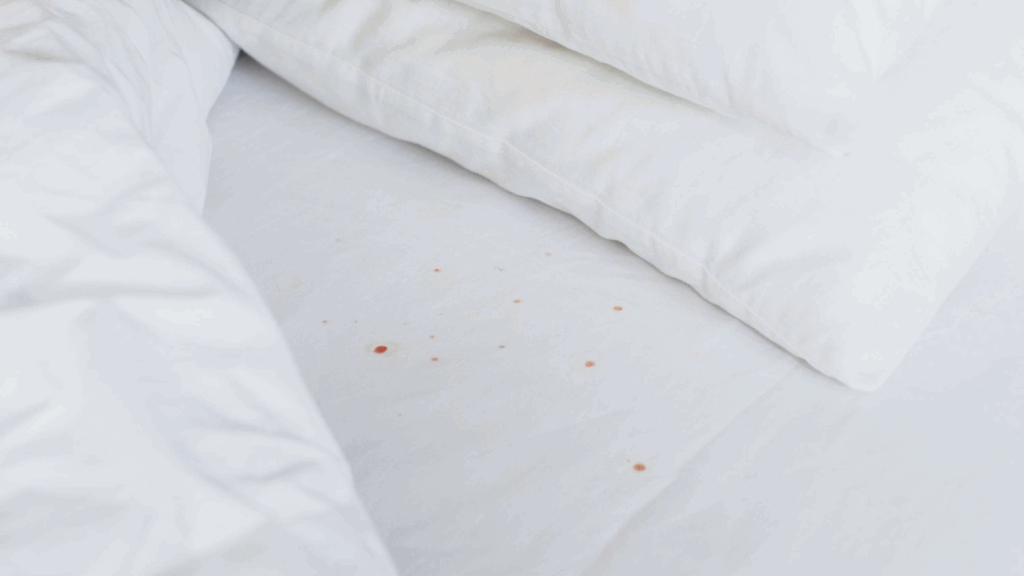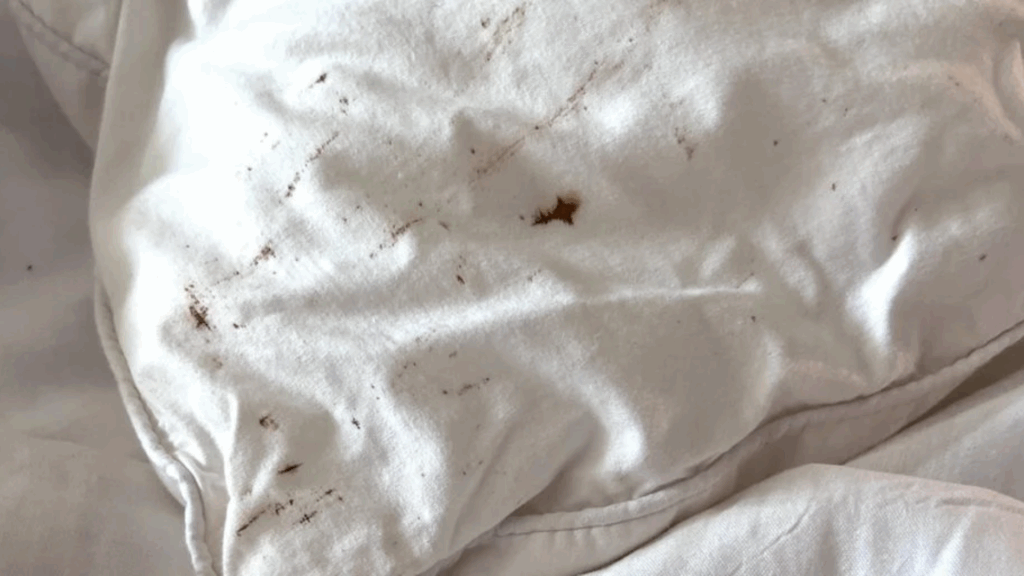Ever woken up to mysterious brown or rust-colored stains on your sheets and wondered, Could it be bed bugs?
I’ve been there. The first time I spotted those marks, I felt confused, grossed out, and honestly, a little panicked. I started looking online for answers, but most pages felt too vague or way too technical.
That’s why I’m writing this, for people like you and me, who just want real answers from someone who’s dealt with it.
I’ve been through the process of identifying bed bug stains, learning what causes them, and figuring out what to do next, step by step, trial and error.
In this blog, I’ll share exactly what helped me and what I wish I’d known sooner.
If you’re trying to figure out if those stains on your sheets mean you’ve got bed bugs, you’re in the right place. Let’s get to it.
What Bed Bug Stains Look Like on Sheets

The first time I saw bed bug stains, I didn’t know what I was looking at. There were these tiny, dark brown spots near the corners of my fitted sheet.
At first, I thought it was just dirt or maybe dried blood from a small cut. But the more I looked, the more I noticed, they weren’t random. They showed up in little clusters, mostly near the seams and edges.
Bed bug stains usually look like:
- Small dark dots or smears (black or reddish-brown)
- About the size of a pen tip or slightly bigger
- Often flat, like ink soaked into the fabric
- Found near where your body lies, pillows, corners, and mattress seams
They’re actually from crushed bugs or their droppings. It’s gross, I know.
But if you see spots like that and can’t explain them, don’t ignore them; it could be your first clue. That’s how it started for me.
What Causes Bed Bug Stains?
Bed bug stains are some of the first visual clues that point to an infestation. These stains may appear on your sheets, pillowcases, mattress seams, or even nearby furniture.
Understanding what causes them helps in early detection and effective treatment.
1. Crushed Bed Bugs After Feeding
One of the most common causes of bed bug stains is the accidental crushing of bed bugs after they’ve fed. Bed bugs feed on human blood, usually at night.
If you shift or roll over in your sleep, you might unknowingly squash them. The blood they’ve just consumed can leave rust-colored smears or dark reddish stains on bedding or mattress surfaces.
2. Bed Bug Fecal Droppings
Bed bugs excrete small amounts of digested blood after feeding. These droppings appear as tiny black or dark brown spots, often described as ink-like marks.
Fecal spots are usually found near the bugs’ hiding places – mattress seams, box springs, headboards, or behind baseboards. Unlike smeared blood, fecal stains are more pinhead-sized and clustered.
3. Shed Skins from Molting
As bed bugs grow, they shed their outer skin during molting. These translucent, yellowish shells may not leave stains on fabrics, but they can be mistaken for dirt or dandruff.
When crushed or mixed with droppings and dust, these remnants may contribute to smudgy or discolored areas near nests or sleeping zones.
4. Eggshell Residue and Dead Bugs
While eggshells themselves are very small (about 1mm) and white, clusters of hatched eggs or dead bed bugs may leave behind faint chalky streaks or residue.
Over time, if left undisturbed, this buildup can become visible on mattress corners or between floorboards, especially when combined with other stains.
5. Blood Spots from Scratching Bites
Bed bug bites often itch, and scratching during the night may lead to broken skin. Bleeding from bite marks can result in small red or brown stains on sheets or pillowcases, which may be mistaken for bug-related stains.
While this isn’t caused by the bugs directly, it’s a secondary result of their presence.
6. Nesting Debris and Waste Buildup
Heavy infestations may cause areas where bugs are nesting to develop combined waste buildup – feces, shed skins, eggs, and dead bugs all concentrated in one place.
These zones often appear as dark patches or dirty clusters in corners, mattress seams, or cracks in furniture, giving off a musty or rusty odor.
Why Bed Bugs Happen?
After I saw the stains and started connecting the dots, I couldn’t help but wonder, How did this even happen?
I keep my place clean, I wash my sheets, and I don’t live in some run-down apartment. But I quickly learned that bed bugs aren’t about dirt or mess.
They’re hitchhikers. You can pick them up almost anywhere: hotels, buses, secondhand furniture, even movie theaters.
All it takes is one bug climbing into your bag, backpack, or clothing. Once they’re in, they find their way to the bed, where we sleep and feed.
In my case, I think I got them from a hotel stay. I didn’t notice anything at the time, but a week later, those stains started showing up.
So if you’re dealing with this, know it’s not a reflection of your hygiene or lifestyle. It’s just bad luck, and it happens more than people admit.
How to Know If It’s Actually Bed Bugs
When I first saw the stains, I didn’t want to jump to conclusions. Could it be bed bugs or just something else?
I started by comparing. Dried blood from a small cut? Maybe. A nosebleed? Possibly. Even old food or makeup stains crossed my mind.
But none of those explained the pattern, small dots near the mattress seams, showing up again even after I washed everything.
Let’s see what helped me figure it out:
- Stain shape: Looked like tiny dark dots that soaked into the sheets, almost like ink, not crusty or raised like dried blood.
- Location: Mostly showed up along mattress seams, corners, and near pillow edges, always in the same spots after washing.
- Bite marks: I started waking up with small, itchy bites in a line across my arm and shoulder, a classic bed bug pattern.
- Smell: There was a faint, musty odor near my bed that I hadn’t noticed before, kind of sweet but strange.
- Droppings: I found black specks on the mattress and wooden bed frame that didn’t wipe off easily.
- Shed skins: Tiny, clear or light brown shells, which bed bugs leave behind as they grow.
- Live bug: One night, I spotted a flat, brown bug near the headboard, about the size of an apple seed. That confirmed it.
I also asked around and read forums, and it turns out I wasn’t alone. Trust your gut. If something feels off, it’s worth checking.
What to Do If You Find Bed Bug Stains
The moment I realized those stains might be from bed bugs, my stomach dropped. I wanted to pretend it was nothing, but deep down, I knew I had to deal with it. Let’s discuss what I did:
1. Don’t panic, but don’t ignore it either
The earlier you catch it, the easier it is to handle. I started by stripping all my bedding, sheets, pillowcases, and even my comforter, and threw them in the wash.
Use hot water and dry on high heat. That’s key. Bed bugs and their eggs die in temperatures above 120°F (about 49°C).
I also bagged up some clothes and anything that had touched the bed recently, just in case.
2. Do a deep inspection of your bed
I grabbed a flashlight and checked every inch of my mattress, especially the seams, corners, and the tag area (bugs love hiding there).
I didn’t find a bunch of bugs, but I did spot more tiny black dots and what looked like clear shell pieces. Later, I found out those were shed skins from growing bed bugs.
I even looked behind my headboard, under my bed frame, and inside nearby drawers. You’d be surprised how far they can crawl.
3. Clean everything thoroughly
I vacuumed my mattress, bed frame, baseboards, and carpet twice. I used a stiff brush to scrub the seams before vacuuming to loosen anything stuck.
After vacuuming, I immediately emptied the canister into a sealed bag and tossed it outside.
Then I wiped down hard surfaces with rubbing alcohol. It’s not a full solution, but it helped me feel like I was taking control.
4. Protect your bed
One of the best things I did was buy a bed bug–proof mattress cover. It zips around the whole mattress and traps any bugs inside so they can’t feed and eventually die.
It also keeps new ones from getting in. I added one to my box spring, too.
I also placed interceptor traps under the feet of my bed. They’re little cups that catch bugs as they try to climb up.
5. When to call a professional
At first, I thought I could handle it alone. But when I kept seeing new stains even after cleaning and covering everything, I called in a pest control expert.
It was expensive, but honestly? Worth it. They checked places I didn’t even think of, behind wall outlets, inside curtain hems, and under rugs.
They used a combination of heat and spray treatments, and I finally started sleeping again without that anxious feeling.
Conclusion
Dealing with strange stains on your sheets is frustrating and honestly a little scary, know because I’ve been there.
When I first saw them, I didn’t know what to think. But once I connected the dots, stain patterns, bites, and weird smells, it all made sense.
I wrote this blog to help make that process easier for anyone going through it. You came here wanting answers about bed bug stains, what causes them, and how to tell if it’s really happening, and I hope you got clear, honest help.
I’ve shared everything I learned the hard way, so you don’t have to feel confused or alone like I did.
Trust what you see, take action early, and know it’s not your fault.
Catching the signs is the first step toward sleeping better, feeling safe, and getting back to normal.

